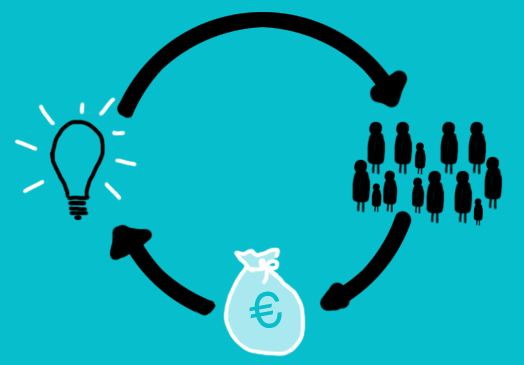What is Crowdfunding?
Over the past few years, crowdfunding has emerged as a popular tool for individuals to raise financing for social causes and business ventures. Entrepreneurs typically raise small amounts of money from a large number of backers, or “the crowd,” usually via the Internet. Backers receive some sort of award or, less commonly, equity- or royalty-based financial return. Crowdfunding platforms, including Kickstarter and Indiegogo, raised approximately five billion dollars in 2013, and the industry is still growing.

For business owners looking to raise capital, crowdfunding is an increasingly popular option. The primary benefit is access to capital based on your reputation and the marketing strategy utilized during the crowdfunding campaign. Unlike with debt financing, entrepreneurs are not evaluated based on the 4 C’s: Cash flow, Credit, Customers and Collateral. Rather, backers decide whether to fund the campaign based on their interest in and support for the cause or the product/service being offered. For startups or businesses launching new products or entering new markets, crowdfunding may be more accessible than other forms of financing.
Back to the Roots
One notable crowdfunding success story is that of Back to the Roots, a business based in Oakland that helps people grow their own food. The company was started in 2009 by two UC Berkeley college graduates, Nikhil Arora and Alejandro Velez, who discovered they could grow mushrooms using recycled coffee grounds. The company started packaging and selling “mushroom kits” and experienced immediate success.

Deciding to branch out beyond mushrooms, the founders began developing a second product: AquaFarms, which allow people to grow their own herbs using aquaponics technology and fish tanks. However, the company needed about $150,000 in working capital to fund the product launch. They decided to run a crowdfunding campaign on Kickstarter and managed to raise $248,000 in 30 days – one of the most successful campaigns ever for a food-based company.
Strategies for Success
So, how did Back to the Roots do it? FundWell spoke with Nikhil Arora, co-founder of the company, who shared some insights about what made the campaign successful.
- Plan, plan, plan. The typical crowdfunding campaign lasts for about 30 days, but planning should start several weeks in advance so that everything is in place during the crucial fundraising stage. Nikhil and his team spent a lot of time researching other campaigns on various platforms to get ideas. They decided to use Kickstarter, which is a great platform for product-based crowdfunding. They also created a strategy for raising the visibility of their campaign video, reaching out to the press and potential backers, and handling customer requests.
- Show it off with a great video. Video content is an important part of a crowdfunding campaign. Most successful campaigns on Kickstarter and Indiegogo have a short video to introduce backers to the project and the people they are funding. If you have the resources, it is definitely worthwhile to produce a high quality video. Back to the Roots worked with videographers at Northbound Films to create a video that introduced and built awareness for their company, their product, and the Kickstarter campaign – all with a personal touch.
- It’s called a “campaign” for a reason. The 30 days of the actual campaign were a wild ride for Back to the Roots. When it was over, observers were amazed at how much money was raised. However, Nikhil says that it’s really a numbers game. “The more people you reach out to, the more money you’re going to get. You’ve got to plan for it and have a strategy in place for how you’re going execute. You have four weeks, and that’s all. It was all about constant outreach. We emailed and called thousands of media blogs and outlets. It ends up being a long 30 days with lots of ups and downs. But you have to slog it out.”
Is Crowdfunding Right for You?
For small businesses, crowdfunding is just one of many different financing strategies. For every success story, there are dozens of crowdfunding campaigns that do not meet their goals. Nikhil has noticed that having a physical product makes a campaign more enticing to backers. More generally, he says you need to have a compelling story: “The biggest thing is make sure the campaign is coming from a place of genuinely needing the capital. Backers should know that you can’t launch this project without their support. If it’s just used as a tool for soliciting advanced orders from prospective clients, it might not be as successful. You need a mission and reason for putting it out there. Focus more on the ‘why’ rather than just getting the money fast. This creates more buzz and more loyalty from your customers and backers.”
What’s Next?
After the 30-day fundraising period, Nikhil and his team weren’t done raising capital. In our next post, we’ll talk about some of the unexpected benefits of crowdfunding for Back to the Roots, including access to additional financing and other supports.